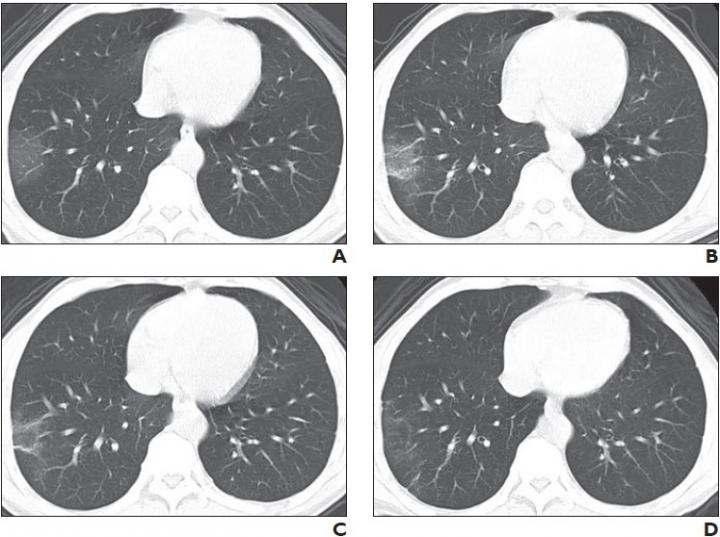Updated CT scoring criteria from AJR considers both lobe involvement and changes in CT findings to quantitatively and accurately evaluate the progression of COVID-19 pneumonia

Credit: American Journal of Roentgenology (AJR)
Leesburg, VA, April 1, 2020–Updated CT scoring criteria that considers lobe involvement, as well as changes in CT findings, could quantitatively and accurately evaluate the progression of coronavirus disease (COVID-19) pneumonia, according to an open-access article in the American Journal of Roentgenology (AJR).
“The earlier that COVID-19 is diagnosed and treated, the shorter the time to disease resolution and the lower the highest and last CT scores are,” concluded lead author Guoquan Huang of Wuhu Second People’s Hospital in China.
Assigning CT scores to 25 patients according to CT findings and lung involvement, Huang and colleagues recorded the time from symptom onset to diagnosis and treatment for each patient. Patients with COVID-19 were divided into two groups: (patients for whom this interval was ? 3 days) and group 2 (those for whom the interval was > 3 days).
Using a Lorentzian line-shape curve to show the variation tendency during treatment, the fitted tendency curves for group 1 and group 2 were significantly different. Peak points showed that the estimated highest CT score was 10 and 16 for each group, respectively, and the time to disease resolution was 6 and 13 days, respectively.
The Mann-Whitney test showed that the last CT scores were lower for group 1 than for group 2 (p = 0.025), although the chi-square test found no difference in age and sex between the groups. The time from symptom onset to diagnosis and treatment had a positive correlation with the time to disease resolution (r = 0.93; p = 0.000), as well as with the highest CT score (r = 0.83; p = 0.006).
“Sequential chest CT examinations enable qualitative investigation of alterations in COVID-19 infection during the course of treatment,” Huang explained.
Because previously proposed CT scoring criteria regarding lobe involvement gave no consideration to changes in CT features (i.e., the change from observation of GGO to a crazy-paving pattern and then consolidation), Huang et al. suggest that such a rubric is not sufficiently accurate to assess the progression of pneumonia.
“In the present study,” wrote Huang, “we propose a new version of CT scoring criteria that considers both lobe involvement and changes in CT findings, in an attempt to more comprehensively evaluate COVID-19 pneumonia on sequential chest CT examinations.”
###
Founded in 1900, the American Roentgen Ray Society (ARRS) is the first and oldest radiological society in North America, dedicated to the advancement of medicine through the profession of radiology and its allied sciences. An international forum for progress in medical imaging since the discovery of the x-ray, ARRS maintains its mission of improving health through a community committed to advancing knowledge and skills with an annual scientific meeting, monthly publication of the peer-reviewed American Journal of Roentgenology (AJR), quarterly issues of InPractice magazine, AJR Live Webinars and Podcasts, topical symposia, print and online educational materials, as well as awarding scholarships via The Roentgen Fund®.
Media Contact
Logan K. Young
[email protected]
Original Source
https:/
Related Journal Article
http://dx.




